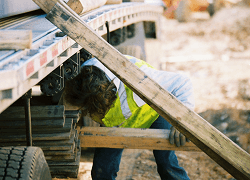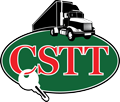Flat Deck
November 28, 2014
Operating flat deck trailers and trucks often requires a great deal more work for the driver, than hauling a van trailer. Loads have to be strapped down, tarped and checked after the first 100km and every two hours thereafter for security.
Drivers remain responsible for the equipment assigned to the truck: straps, tarps, tarp straps, winch bar, chains, and binders. The most common freight transported on flat deck trailers and trucks is lumber, building products, equipment, and steel; however, anything that can be secured to the deck and tarped, can be safely transported.

Drivers must possess extensive knowledge about load placement and tie downs, as they are ultimately responsible for load security.
Pros
Operating a flatdeck trailer provides exercise for the driver. Strapping down equipment and ‘pulling’ tarps can be arduous work. This work associated with flatdecks provides a sometimes-welcome break from the long miles associated with driving long haul. Also, for those drivers that take pride in their work, a well-tarped load illustrates the professionalism of a good driver.
Cons
Strapping and tarping a load in rain and high winds can test the patience of the most seasoned driver. When tarping and strapping, drivers are dirty and sweaty; in many places where drivers load, a shower is often not available, so he has to wait for the first available truck stop. In this case, wet wipes, and portable camp showers do wonders for the trucker on the road.
Moreover, tarps are heavy and can lead to injury such as back pain, strains and pulled muscles. Also, drivers working on top of loads are susceptible to falls when pulling tarps and strapping loads.
One other aspect of hauling flat deck loads, particularly if the tractor and trailer are not equipped with an air suspension guage, is overweight fines. Many of the larger transport companies equip their vehicles with these gauges to give their drivers an estimate of the weight on their truck, but some of the smaller companies do not. It is the driver’s responsibility to find a scale, and if not pay the fine that may be imposed. If a driver is caught at the scale with an overweight load, it is her that is gets the fine. If the load has to be redistributed or some of it off-loaded, the company is often saddled with the cost of bringing out a crane and shipping the excess freight.
(Photo by johnantoni / CC BY)





